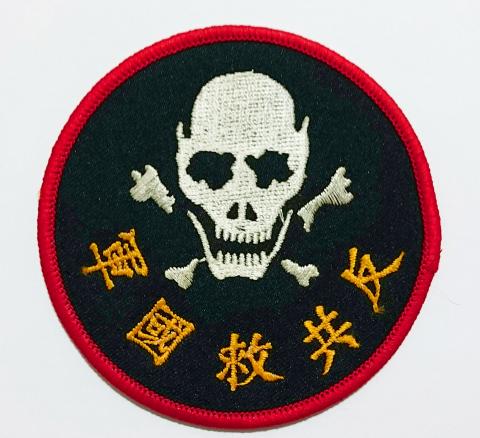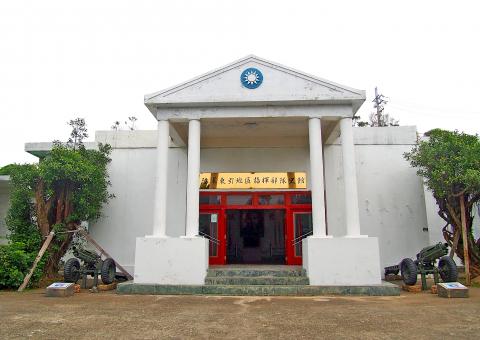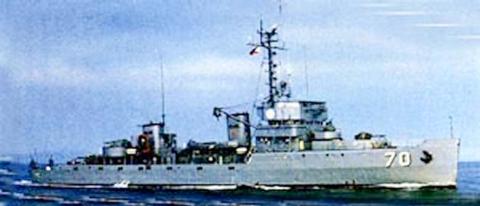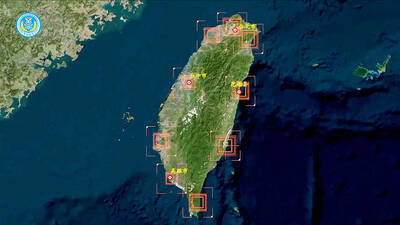Nov. 18 to Nov. 24
Fan Chen (樊鎮), a “model revolutionary soldier deeply influenced by the Three Principles of the People” and a captain in the Anti-Communist Advance Army (反共挺進軍), successfully landed in China’s Zhejiang Province with 11 subordinates on June 27, 1963.
When ambushed by People’s Liberation Army troops en route to the “target area,” Fan stayed behind to hold off the enemy so his comrades could go on, “achieving his vow to give his life for the mission.”

Photo courtesy of the Dongyin Anti-Communist National Salvation Army Veterans Association
Fan was one of 21 “anti-communist martyrs” (反共烈士) honored on the front page of the Central Daily News (中央日報) on Nov. 23, 1964, all losing their lives in similar situations after infiltrating different areas along the coast of Communist-ruled China between 1950 and 1963. They were either members of the Anti-Communist Advance Army, the Anti-Communist National Salvation Army (反共救國軍) or agents who were already behind enemy lines.
According to the report, these martyrs were tasked with supporting the “holy war against the communists” by “planting seeds and lighting fires” in China. “They have not only caused the illegitimate regime to panic, but have also garnered much international attention.”
“They have established bases across China and have linked up with local anti-communist forces, greatly expanding the anti-communist presence in China,” the report states, adding that there were countless more who gave their life for the cause.

Photo courtesy of National Central Library
INFILTRATING CHINA
Republic of China (ROC) military groups had been operating off the coast of China since the Chinese Nationalist Party (KMT) retreated to Taiwan in 1949, continuing to clash with the communists throughout the decades. They received significant US support, especially after the Korean War broke out in 1950. In 1960, the different brigades were reorganized into a singular Anti-Communist National Salvation Army based at Dongyin (東引), one of the Matsu Islands off the Chinese coast.
Profiles of the featured martyrs provide a glimpse of the anti-communist activities since the end of the Chinese Civil War. In 1949, Fujian native Pan Hao-hsing (潘皓興) fled to the hills and engaged in guerilla resistance against the People’s Liberation Army; he officially joined the KMT resistance in 1950 and served as one of its contact points within China. He died trying to rescue a comrade that December.

Photo courtesy of Wikimedia Commons
Han Wen-chu (韓問渠), the only female on the list, became a secret agent for the KMT in Jiangsu Province in 1953 to avenge her husband. She was captured, interrogated and killed.
By 1954, the KMT still ran the Zhejiang Provincial Government from Dachen Island (大陳), where a branch of the Anti-Communist National Salvation Army was stationed. Zhejiang native Wang Yi-tsai (王義才) had retreated to Taiwan with the KMT, but in 1954 he headed to Dachen with plans to infiltrate China. When the People’s Liberation Army (PLA) overran Dachen in February 1955, Wang pretended to be a KMT hostage and joined the PLA as a spy. He was executed when he blew his cover. Liang Chu-cheng (梁居正) had the most illustrious career on the list, completing five missions into enemy territory between 1953 and 1958. He was caught on the sixth and executed.
A 1965 Taiwan Review article details the activity of the army, noting that that before 1962, “the emphasis was on information gathering and the planning of underground organizations. Now, the information is being used and the plans are being carried out. Many groups of commandos have conducted probing attacks along the mainland coastline during the last two years.”

Photo courtesy of Wikimedia Commons
The Central Daily News article also mentions this increased activity, noting that between March 1962 and November 1963, 56 brigades consisting of 1,785 soldiers had successfully conducted operations in China. “Five provinces along the coast and strategic inland locations have felt the blows of guerrilla and commando bands,”the Taiwan Today article states.
The article speaks glowingly about the successes of these operations, pays respect to a few failures and concludes that “they are the vanguard of the struggle for a free and peaceful China, and of a victory that must be won before the Chinese Communists can spread nuclear devastation across the earth.”
THE GUOGUANG PROJECT
The intensifying military activity in 1963 is likely tied to the Guoguang Project (國光計畫), initiated in 1961 to take advantage of China’s disastrous Great Leap Forward and launch a full-scale invasion.
The plan appears to be highly unrealistic. Admiral Wang Ho-su (王河肅) recalls in an oral history book published by the Ministry of National Defense that they were to launch a surprise attack on Xiamen and quickly establish a base, cut off the railroad and then either invade Guangdong or Fujian from there. So much of the plan’s success depended on external factors, including US military aid, the anti-communist sentiments of the Chinese as well as the questionable loyalty of the former KMT troops who had been stranded in China for over a decade.
The US predictably was not supportive, and meanwhile, China successfully tested its first nuclear weapon in October 1964. Chiang reportedly was adamant on the invasion, stating: “There is no way that we will wait for American permission!” Judging from the various accounts in the oral history book, nobody dared to speak out against Chiang.
On June 17, 1965, Chiang made a dramatic pep talk to the officers at the ROC Military Academy, noting that the “counterattack on the mainland” would soon begin and that they should write their wills in advance.
Things did not go smoothly at all. A landing drill on June 24, 1965 ended up in disaster, when strong waves overturned five amphibious assault vehicles, causing over 10 deaths. On Aug. 6, two warships set out to transport agents to China for advance scouting, but the PLA had already caught wind of the mission. It dispatched a torpedo fleet that intercepted the warships at sea, sinking both and killing around 200 troops. Admiral Hsu Hsueh-hai (徐學海) recalls that the ROC Air Force was not informed of this mission due to a communication error, and its reinforcements arrived too late.
“The failure of this challenging mission directly affected [Chiang’s] confidence and determination. He was already very old and sick, and there was nobody who could replace him as a top decision maker. So the plan to retake China was shelved,” recalls General Chu Yuan-tsung (朱元琮).
Taiwan in Time, a column about Taiwan’s history that is published every Sunday, spotlights important or interesting events around the nation that have anniversaries this week.

The People’s Republic of China (PRC) last week offered us a glimpse of the violence it plans against Taiwan, with two days of blockade drills conducted around the nation and live-fire exercises not far away in the East China Sea. The PRC said it had practiced hitting “simulated targets of key ports and energy facilities.” Taiwan confirmed on Thursday that PRC Coast Guard ships were directed by the its Eastern Theater Command, meaning that they are assumed to be military assets in a confrontation. Because of this, the number of assets available to the PRC navy is far, far bigger

The 1990s were a turbulent time for the Chinese Nationalist Party’s (KMT) patronage factions. For a look at how they formed, check out the March 2 “Deep Dives.” In the boom years of the 1980s and 1990s the factions amassed fortunes from corruption, access to the levers of local government and prime access to property. They also moved into industries like construction and the gravel business, devastating river ecosystems while the governments they controlled looked the other way. By this period, the factions had largely carved out geographical feifdoms in the local jurisdictions the national KMT restrained them to. For example,

The remains of this Japanese-era trail designed to protect the camphor industry make for a scenic day-hike, a fascinating overnight hike or a challenging multi-day adventure Maolin District (茂林) in Kaohsiung is well known for beautiful roadside scenery, waterfalls, the annual butterfly migration and indigenous culture. A lesser known but worthwhile destination here lies along the very top of the valley: the Liugui Security Path (六龜警備道). This relic of the Japanese era once isolated the Maolin valley from the outside world but now serves to draw tourists in. The path originally ran for about 50km, but not all of this trail is still easily walkable. The nicest section for a simple day hike is the heavily trafficked southern section above Maolin and Wanshan (萬山) villages. Remains of

With over 100 works on display, this is Louise Bourgeois’ first solo show in Taiwan. Visitors are invited to traverse her world of love and hate, vengeance and acceptance, trauma and reconciliation. Dominating the entrance, the nine-foot-tall Crouching Spider (2003) greets visitors. The creature looms behind the glass facade, symbolic protector and gatekeeper to the intimate journey ahead. Bourgeois, best known for her giant spider sculptures, is one of the most influential artist of the twentieth century. Blending vulnerability and defiance through themes of sexuality, trauma and identity, her work reshaped the landscape of contemporary art with fearless honesty. “People are influenced by